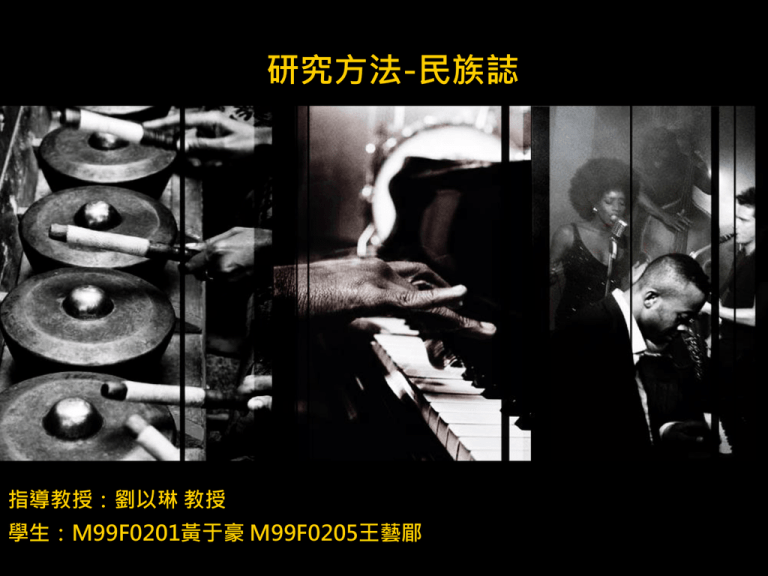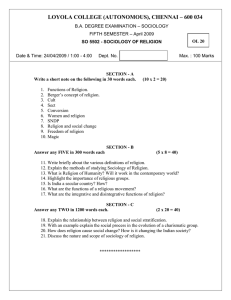
研究方法-民族誌
指導教授:劉以琳 教授
學生:M99F0201黃于豪 M99F0205王藝郿
Opportunities for ethnography in the
sociology of music
民族誌在音樂社會學中的新契機
Reference
Sociology Department, University of Pennsylvania,
3718 Locust Walk,Philadelphia, PA 19104-6299, USA
賓夕法尼亞州大學,社會學系
Author:David Grazian
Available online 2 July 2004(2004年7月2號刊出)
# 2004 Elsevier B.V. All rights reserved.
目錄
Abstract摘要
1. Introduction序論
2. The ethnographic tradition in sociology社會學裡的傳統民族誌
3. Producing music音樂產業的產制
4. Subcultures and style次文化及其形態
5. The consumption of music and the self音樂產僅選購與自身關係
6. New directions in the sociology of music音樂社會學研究的新趨勢
6.1. Gender性別
6.2. Spaces and places空間和地域性
6.3. The effects of globalization全球化的影響
7. Opportunities for ethnography in the sociology of music
民族誌在音樂社會學中的新契機
Abstract摘要
Since the 1920s the sociological study of music has
greatly benefited from the contributions madeby researchers
who use ethnographic methods in their work, and in this
article I review some of thisnoteworthy scholarship
1920年人種誌研究運用於音樂產業有持續十年的全盛期
音樂產業X區域性研究
音樂產業X性別研究
音樂產業X全球化研究
Ethnography:人種誌
意指「描寫民族」之意,又可稱為民族誌、民俗誌
Introduction緒論
sociological ethnography has referred specifically to
the task of the participant observer who ‘‘gathers data
by participating in the daily life of the group or
organization he studies’’ (Becker, 1958: 652).
人種誌研究起緣於人類學者的使用,在社會科學中人
種誌重視實做層面,而這些實做是從學者觀察及解釋文化
信仰和社會團體間人與人的交集而得來之結果
在傳統中,社會科學的人種誌研究中提及觀察者的任
務就是「親身參予他所研究的團體並蒐集相關資料」
是屬於「互動性」的研究
近幾年質化研究方法被廣泛運用,此篇文章中筆者探討了從早期的芝
加哥學派到近期當代是如何將民族誌法運用於音樂產業研究中
古典時期
30年代→
現代時期
50年代→
特點
記錄觀察者自己 融入研究對象
所見為主
生活
帶有浪漫色彩及 田野調查
種族中心主義
有系統的紀錄
缺點
不夠客觀
沒有依據
著重「人」本身
的研究,忽略外
在其他因素
後現代時期
80年代→
符號互動論、
女性主義和批判
理論等興盛
強調真實呈現與
研究對象之間的對
話
The ethnographic tradition in sociology
社會學裡的傳統民族誌
Important research
1929年
Harvey Warren Zorbaugh -The Gold Coast and the Slum
黃金海岸和貧民窟
1932年
Paul G. Cressey -the latter typically Asian
後期亞裔移民舞者
1933年
Walter C. Reckless -how popular music scenes operate
within a larger cultural ecology of urban
nightlife
流行音樂如何在城市夜生活的文化生態裡運作
1932年
Paul G. Cressey -the latter typically Asian
後期亞裔移民舞者
Cressey relies on close participant the latter typically
Asian immigrants who relied on these dance halls and their
live music as entry points into the social world of American
life
Paul G. Cressey研究芝加哥的舞廳
Paul G.接近那些舞者與他們的男性顧客並觀察和詳細查訪,發現那些後
期移民至美國的亞洲僑民舞者,是以舞廳這個場域和現場音樂進入美國
社交生活
1933年
Walter C. Reckless -how popular music scenes operate within
a larger cultural ecology of urban
nightlife
流行音樂如何在城市夜生活的文化生態裡運作
To a slumming white patronage the Black Belt location of
cabarets offered atmosphere and the colored man’s music and
patronage added thrill.
Walter C在那充滿禁忌的時代以爵士樂表演地點、公開舞廳和歌舞
劇表演場地為研究要點,他用人種誌強調白人讓自己與黑人有重要象
徵性的連結
白人顧客光顧黑人群聚的歌舞廳,他們認為黑人舞廳提供了的特有
的氣氛和爵士音樂,且因種族情結,使白人感到新鮮且刺激
The legacy of these Chicago school investigations lies in
(1)their use of the case study as a legitimate form of
sociological inquiry
(2)an attention to participant observation and other types
of ethnographic fieldwork
(3)an emphasis on the interactional fields in which urban
culture is produced, marketed and consumed. These
examples would continue to influence ethnographic work
in the sociology of music over the course of the
twentieth century.
這些早期芝加哥學派的研究發現
(1)這些案例研究可作為合法形式的社會學研究借鏡
(2)可嘗試觀察和參與其他類型的田野調查
(3)強調人與音樂和城市文化的互動是透過生產、銷售和消費而來
Producing music 音樂產業的產制
While the contributions of the Chicago school add to our
knowledge of how music cultures operate in the urban milieu
Through a variety of techniques, including extensive
participant observation, interviewing, and recording songs
and oral narratives
芝加哥學派對於音樂文化與都市環境的研究貢獻加劇
民族誌學者開始透過多種技術,包括廣泛的參與觀察、採訪、
記錄歌曲和口頭說明,實地觀察研究
Important reasearch
1965年
lan Lomax (1993), Paul Oliver (1965), and David Evans (1982) –
created vivid and illustrative portrayals of the Mississippi
Delta and its folk blues culture
生動描繪說明密西西比河三角洲布魯斯及其民俗文化
1966年
Charles Keil -studied Chicago blues and soul singers
研究芝加哥藍調與靈魂歌手
1981年
Samuel Charters –
researchedWest African tribal performers (or griots) thought
to be the originators of what would come to be the American
blues tradition
研究西部非洲部落的表演,他認為是這是美國傳統藍調的來源
the ethnomusicological approach to blues research
suffered from a number of related weaknesses: its
presentation was generally impressionistic, rather than
systematic; its intellectual goals were descriptive and
explanatory, but not theoretical; and its orientation was
romantic instead of critical. As a result, classic
ethnomusicology evaded an analysis of how more contemporary
professional, economic and institutional forces structure
the production of popular music.
民族誌研究運用在藍調音樂的調查上有點薄弱,其描述是印
象主義的,而不是有系統的,他主要是描述和說明,但不構成理
論,那些文獻過於傳奇浪漫及種族中心主義而非關鍵性的,舊派
的民族誌研究逃避了解釋關於經濟上的、組織制度上的力量構造
流行音樂的生產
※只注重在人本身,卻忽略了經濟和政府的影響
Sociology, on the other hand, was much better equipped
to compensate for these gaps,and from the mid-1950s
onward ethnographers explored the commercial contexts in
which musicians produce their craft not only as inspired
artists, but as employed professionals as well (Becker,
1982).
另一方面的社會學就有填補這議題不足的地方,從50
年代中期民族誌學者探索商業脈絡對於音樂生產的影響
而不只是從藝術的角度
Important reaserch
1963年
Howard S. Becker-jazz musicians
研究藍調樂手
Becker參與觀測並獲得實證數據和理論見解
在中產階級統治者的規範下必須樂手自力救濟
1971年
Robert R. Faulkner–classically trained orchestral musicians
研究早期管弦樂家
1980年
H. Stith Bennett-local rock musicians
研究當地搖滾樂
更清楚的描述了民族誌方法如何運用於音樂發展
主觀性套用在有形的事物上,商業的要求及期望中
These ethnographic studies developed out of three
related paradigms made popular within sociology at this
time: the influence of Everett C. Hughes and his work on
occupations; the rise of symbolic interactionism; and
the strengths of labeling theory and the social
construction of deviant behavior.
這時民族誌研發出三個相關的理論:
Everett C. Hughes和他的職業影響(意指研究者本身的客觀性也是重要因素)
符號互動論的興盛
標籤理論的力量和異常行為的解釋
※社會中的主流文化團體藉著製造一些規則,並規定違反這些規則者即構成
偏差,然後將這些偏差行為者貼上標籤
Subcultures and style 次文化及其形態
民族誌研究音樂與次文化關聯是以青少年為主要研究對象
70年代受到後現代的衝擊,民族誌強調以「對話」式或多重聲音
的敘述方式取代人類學家的獨白,強調與報導對象之間的對話,真實
呈現研究者與研究對象的互動內容
Important reasearch
1950年
David Riesman -younger teenagers and Subcultures
1975年
青少年與次文化研究
Hall and Jefferson -how young people rely on the creative
potential of music to develop symbolic
青少年如何創造自身音樂符號
1950年
David Riesman -younger teenagers and Subcultures
青少年與次文化研究
David Riesman provided an exception to this rule by
conducting lengthy open-ended interviews with his students
and a sample of younger teenagers. He found that American
youth could be divided into two groups. The majority
followed conventional adolescent tastes while a minority
of active listeners exhibited their distaste for
commercial music and celebrity performers. These latter
consumers developed their musical preferences within the
context of peer groups who expressed a disdain for
conformity to the cultural mainstream.
David Riesman進行了冗長的開放式採訪他的學生和青少年。他發現,
美國年輕人可以分為兩類:「消極地接受了商業所給予的風格和價值」的
人,另一種則是「積極地尋求一種小眾的風格」的人,也就是次文化
1975年
Hall and Jefferson -how young people rely on the creative
potential of music to develop symbolic
青少年如何創造自身音樂符號
Grazian and other bohemian groups, researchers explored
how young people rely on the creative potential of music
to develop symbolic and aesthetic practices in concert
with other elements of style, including fashion, body
adornment, dance, drug use and slang. Reacting to the mass
culture critique, these scholars argued that the
consumption of music represented a class-conscious form of
rebelliousness, or ‘‘resistance through rituals’’
Hall and Jefferson發現青少年會運用服飾,飾品,舞蹈,吸毒
和俚語等外象表徵創造自身的音樂符號和審美習慣
反應到大眾文化的批判,這些學者認為,次文化音樂代表消費者
透過一些儀式或表徵反抗主流文化並創造自身風格
The consumption of music and the self
音樂產品選購與自身關係
Important research
1990年
Paul Willis -young people attach to popular music
青少年與流行音樂
1999年
Tia DeNora-emphasizes the elemental relationship
existing between music and the body
音樂如何反映人與自然的關係,以及音樂與環境變化的互動
Paul Willis emphasizes the meanings and practices that
young people attach to popular music. According to Willis’s
informants, music serves as a resource for generating meaning
through the selective interpretation of memorable lyrics and
styles of performance. He argues that through activities such
as home recording and creating a ‘‘personal soundscape’’
inside one’s head with the help of Walkman earphones,
listening to music presents opportunities for developing a
political consciousness, gaining spiritual nourishment, and
making sense of pivotal milestones and life experiences.
Paul Willis 主張理論 :
研究強調青少年對於流行音樂的實踐和個人化過程
Willis’s認為青少年會經由音樂中的歌詞和音樂表演風格做個人
化解讀,透過拼貼,文化的符碼被組織成為新的意義青少年的次
文化,並創造更多個人化經驗
New directions in the sociology of music
音樂社會學研究的新趨勢
During the 1990s a number of themes emerged in the
ethnographic literature on music, each simultaneously
responding and contributing to larger trends within
qualitative sociological research. Below I will address three
topics in particular: gender and the role of women in music;
the reemergence of urban space and its relationship to
cultural processes; and the impact of globalization on local
music subcultures and their scenes.
筆者針對三個議題做為民族誌新趨勢的討論:
1.性別和女性在音樂產業中角色
2.音樂中城市空間和文化關係的重現
3.全球化對於次文化音樂和他們場域的影響
Gender
As demanded by an increased concern with gender
differences in music-making, during the 1990s
ethnographers turned to an examination of the
position of women within worlds of music production
and consumption. In particular, this work emphasizes
three distinct social roles inhabited by women:
active (as opposed to passive) cultural consumers;
young girls and adolescents who maintain shared
notions of femininity and sexuality; and marginalized
workers organized into sex-segregated occupations.
20世紀 90年代人類學家轉向研究女性在音樂生產和消費
中的地位,特別是這項研究強調了三種不同女性在社會中扮演
的角色:轉變為積極的文化消費者,年輕女孩和青少年性觀念
較為開放,非主流的工作組織會按性別化分工作職位
1998年
Jessica Rosenberg and Gitana Garofalo
Regarding the collective subcultural life often shared by
female youths, conduct focus groups with music fans
associated with the profeminist riot-grrrl movement of the
1990s, and explore how young women draw on the symbolic
elements of music in order to collectively forge gendered
identities
次文化組織常常是由女性所組成的,Jessica Rosenberg和
Gitana Garofalo在1990年率先研究了riot-grrrl「暴女」這個組
織,調查她們如何將女性象徵元素運用於音樂中並力求男女平等
(也將性別議題帶入了搖滾圈)
1999年
DeNora accounts for how women actively consume music in their
domestic,work and leisure spaces as a means of negotiating the
challenges of everyday life.
DeNora記述女性如何積極購買及沉迷音樂,使在她們的家庭中、工作
中等更有鬥志及活力
Spaces and places
In addition to gender, the 1990s bore witness to the
increased significance of space as a contextual
variable in cultural and urban sociology.
除了性別,90年代見證了更多的空間意義,作為文化
和城市社會學的研究背景
1990年
Arjun Appadurai-the increased significance of space as a
contextual variable in cultural and urban sociology
流動與跨界社會空間的學說,音樂學者逐漸意識到幾個當代議題:音樂如
何跨界,跨界的音樂又如何協助重建社會空間或再創傳統;近年來,更著
重於音樂表演、跨界空間及認同之間關係的探討
The effects of globalization
Contemporary studies of globalization argue that
international flows of immigrants and capital impact
the cultural geography of local spaces and places
1990年
Appadurai / Sassen / Hall -globalization argue that
international flows of immigrants and capital impact
the cultural geography of local spaces and places
當代研究認為,全球化對當地移民的文化空間和場所造成了
衝擊,全球化趨勢勢必對音樂帶來影響,最近民族誌研究強調
全球化的演進過程中對當地的音樂文化造成什麼影響,也演繹
出多種新型的質化風格
Opportunities for ethnography in the sociology of music
民族誌在音樂社會學中的機會
I conclude with three suggestions for new foci in
ethnographic research in the sociology of music: the use
of popular music in the marketing of urban areas; the
production process within the culture industries; and the
consumption of music in real time and space.
最後筆者提出三點建議新人種學在研究音樂社會學時應注意:
1.流行音樂產業在城市中的行銷
2.文化產業中的生產過程
3.購買音樂的確切時機和地點
民族誌社會學家可以幫助理解地域性及其音樂文化以及政府
間的複雜關係,具體來說可依靠三種研究方法:
1.流行音樂產業在城市中的行銷=開放式訪談X當地民眾X城市圖像真實性
2.文化產業中的生產過程=增強過去理論和現在的量化研究X音樂生產過程
3.購買音樂的確切時機和地點=量化研究X質化研究
THANK YOU FOR YOUR LISTENING



